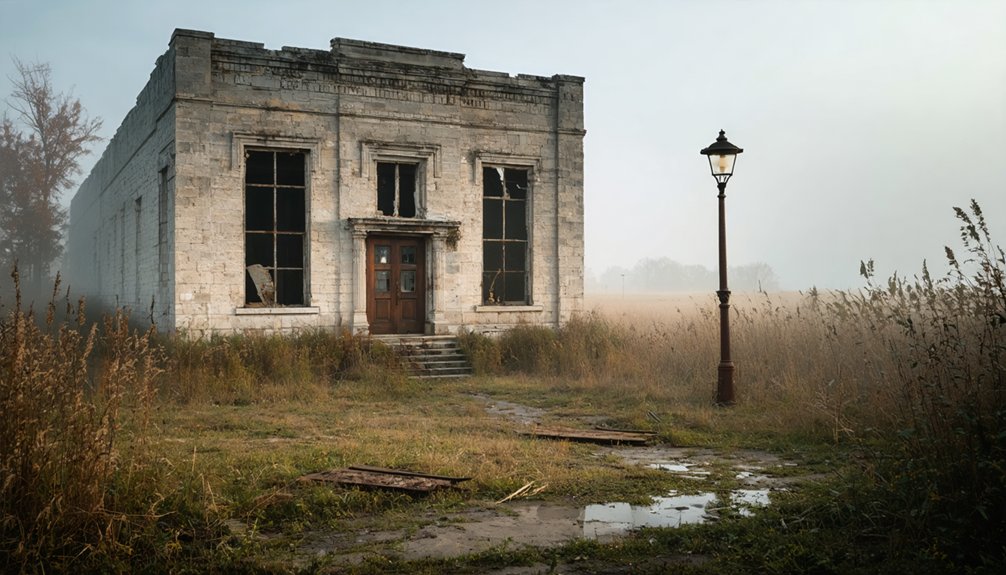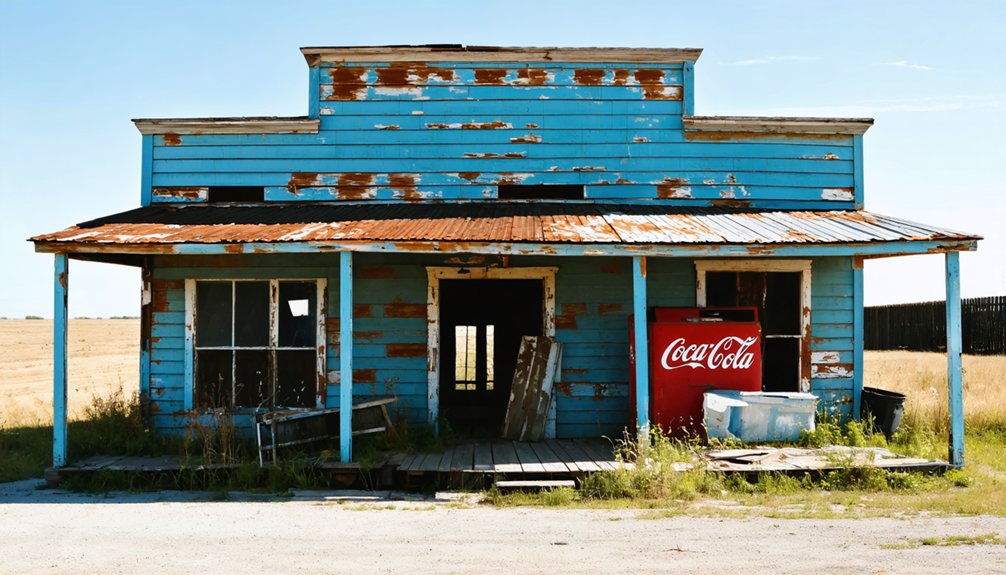You’ll find Owensville, Texas, 3.8 miles north of Franklin on Farm Road 46, where it served as Robertson County’s seat from 1855 to 1869. D.H. Love donated the land along the Houston-Waco route, and the town quickly flourished with a courthouse and post office. A devastating yellow fever epidemic and the bypass of the Houston & Texas Central Railway led to its decline. Today, the historic cemetery and Texas Historical Markers preserve its remarkable past.
Key Takeaways
- Owensville served as Robertson County’s seat from 1855 to 1869 before declining after being bypassed by the Houston & Texas Central Railway.
- The town was abandoned after losing its county seat status to Calvert in 1870, with its post office closing by 1872.
- Yellow fever epidemics devastated the population, causing many residents to flee and deterring new settlers from establishing homes.
- Despite revival attempts between 1895 and 1897, Owensville never recovered its former prominence as a regional administrative center.
- Today, only the historic Owensville Cemetery remains as a testament to the former town’s existence and cultural heritage.
The Birth of a County Seat (1855)
When Robertson County officials sought a new county seat in 1855, D.H. Love stepped forward to donate land for what would become Owensville. Located strategically along the Houston-Waco route, about five miles northwest of Franklin, this new county seat quickly attracted settlers and commerce.
You’ll find that Owensville’s town growth was remarkably swift. Within a year of its founding, the town established a post office and relocated the courthouse from Wheelock. The town was named in honor of Harrison Owen, the first county clerk who served from 1838 to 1847.
The prime location on the mail, stage, and freighting road made it an ideal spot for development. As the community flourished, it drew public officials, doctors, lawyers, and various businesses. A wooden two-story courthouse was constructed under contract by A.L. Brigance in 1856.
The establishment of Owensville Cemetery, with burials dating back to 1846, further cemented the town’s significance as a growing administrative and commercial center.
Harrison Owen’s Legacy and Early Governance
As Robertson County’s first clerk from 1838 to 1847, Harrison Owen left such an indelible mark on local governance that officials named their new county seat in his honor.
During his tenure, he established the foundational record-keeping systems that would shape the county’s administrative future.
Owen’s influence extended well beyond his years of service. When Owensville became the county seat in 1855, nearly a decade after his clerkship ended, the governance structure had evolved into a complex network of public officials, lawyers, and business leaders.
The town’s courthouse, completed in 1856, centralized all legal proceedings and administrative functions.
While Owen didn’t participate directly in Owensville’s operations, his early work laying the groundwork for county government earned him a lasting legacy that survives in historical markers today.
The new courthouse quickly became the hub for commerce, attracting merchants and professionals who established businesses around the square.
Life During the Civil War Years
During the Civil War era, Owensville stood as a vital administrative hub for Robertson County, dispatching soldiers and providing essential support for civilians caught in the conflict.
Owensville served Robertson County as a wartime command center, mobilizing troops and sustaining local communities through the Civil War’s darkest days.
You’ll find evidence of the town’s significant military contributions in the records of armed soldiers who departed from its streets to fight for Texas’s cause.
The war’s impact echoed through the courthouse halls, where officials processed the estates of fallen soldiers like Francis Barziza and Dr. Belvedere Brooks. Among those who served was Major William Hurley, a First Lieutenant in Texas State Troops.
Life changed dramatically after the war when military rule and radical governance took hold. The cemetery’s grounds reflect this tumultuous period through its segregated burial sections, dividing black and white residents.
You’d have witnessed the growing frustration among citizens as trust in local leadership eroded. This period of upheaval marked the beginning of challenging times for Owensville, foreshadowing the town’s eventual decline.
Education and Social Development
While Owensville flourished as the county seat, its academy stood as Robertson County’s premier educational institution, drawing students from prominent local families across the region. The academy served as both a learning center and social hub, reflecting the community’s educational aspirations during a transformative era that included the Civil War. Similar to the Rosenwald School in Tatums, educational access remained a critical concern for the area’s development.
The community’s prominence was strengthened by its strategic position along the Houston-Waco mail route, which facilitated communication and trade. You’ll find that social cohesion in Owensville was complex, marked by racial segregation evident in institutions like the town cemetery. While Black residents contributed considerably to the community’s culture, they were often excluded from main civic spaces.
The town’s educational prominence eventually declined following yellow fever outbreaks and population losses, accelerating after the county seat’s relocation. Today, only the historic cemetery remains as a representation of Owensville’s once-vibrant educational and social life.
The Yellow Fever Epidemic’s Impact
You’ll find that yellow fever struck Owenville with devastating force, spreading rapidly through the unsanitary conditions and mosquito-rich environment typical of 19th-century Texas towns.
Similar to Calvert’s experience in 1873, where three to four hundred residents perished, the death toll mounted quickly as the disease progressed through the population, causing many survivors to flee the area permanently. The symptoms were particularly gruesome, with victims suffering from black vomit as hemorrhaging occurred in severe cases.
This epidemic, combined with other challenges facing the settlement, delivered the final blow to Owenville’s hopes of becoming a thriving community.
Disease Spreads Through Town
Like many Texas settlements of the era, Owenville faced devastating consequences when yellow fever struck the region in the 1830s.
Disease transmission accelerated through the community as the Aedes aegypti mosquito thrived in the warm, humid climate and standing water of local marshes. The virus likely reached Texas through the slave trade routes from Africa.
You’d have witnessed these harrowing developments in Owenville:
- The community response mirrored other Texas towns, with residents forming aid organizations similar to the Howard Association.
- Trade and commerce ground to a halt as quarantines were strictly enforced.
- Local physicians attempted treatments like bleeding and opium, following Dr. Ashbel Smith’s documented approaches.
- The town’s population dwindled as both death and fear of infection drove residents away.
The epidemic’s impact would ultimately contribute to Owenville’s decline, as the disease’s reputation deterred new settlers and economic growth.
Death Toll Devastates Community
Three devastating waves of yellow fever swept through Owenville during the epidemic, claiming hundreds of lives and forever altering the town’s destiny.
As you’d expect in port communities of that era, the town’s epidemic response proved inadequate against the disease’s rapid spread. You’ll find that recent immigrants and poorer residents suffered the heaviest losses, with mortality rates reaching up to 60% among the infected.
The town’s community resilience was tested as the disease progressed from fever and muscle aches to the dreaded black vomit, jaundice, and organ failure.
Death often came within two days of severe symptoms. Those who could fled, while others faced quarantine measures that ultimately failed.
The economic impact devastated local commerce, and the town never fully recovered from these losses.
Final Blow to Owensville
While initial yellow fever cases trickled into Owensville through trade routes and asymptomatic carriers, the disease’s full impact devastated the town with ruthless efficiency.
The epidemic response proved particularly challenging as you’ll discover through these essential factors that sealed Owensville’s fate:
- Enforced quarantines halted critical trade and commerce, isolating the community when resources were needed most.
- Limited medical knowledge led to ineffective treatments, resulting in high mortality rates.
- The town’s attempts to conceal the outbreak delayed vital preventive measures.
- Environmental conditions, including warm climate and unsanitary marshlands, created perfect breeding grounds for disease-carrying mosquitoes.
Despite attempts at community resilience, these combined pressures proved too much for Owensville to overcome, ultimately leading to its abandonment as residents fled the recurring threat of yellow fever.
Decline and Loss of County Seat Status

After serving as Robertson County’s seat for fourteen years, Owensville’s status began to crumble in 1869 when the Houston & Texas Central Railway bypassed the town.
You’ll find this marked the beginning of significant economic challenges, as businesses and residents lost access to essential transportation routes that connected them to regional commerce.
The population decline accelerated when County Judge I.B. Ellison declared Calvert the new county seat around 1870, moving all courthouse functions and government records there.
Calvert’s strategic location along the railroad made it a more practical choice for the county’s administrative center.
By 1872, Owensville’s post office had closed, and despite a brief revival attempt from 1895 to 1897, the town couldn’t recover.
The once-thriving community gradually faded away, leaving only its cemetery by the 20th century.
The Historic Owensville Cemetery
Today, the historic Owensville Cemetery stands as the last physical remnant of the former county seat. The cemetery’s significance extends beyond its role as Robertson County’s oldest organized burial ground, offering profound insights into the area’s cultural heritage and burial practices spanning nearly 200 years.
- Established in 1837 with its earliest recorded burial, the cemetery evolved from scattered family plots into a formal community site by 1869.
- You’ll find it divided into East and West sections that reflect past segregation, though the dividing fence was removed in 2024.
- Notable African American figures like T.D. Davis and Rev. Robert Neal rest in the West section.
- You can access this historic site 3.8 miles north of Franklin on Farm Road 46, following Farm Road 979 to Owensville Cemetery Road.
Cultural Significance and Racial History

As you explore the old Owensville cemetery today, you’ll notice the stark physical barrier that once separated Black and white burials, reflecting the community’s rigid segregation practices.
The cemetery’s dual nature tells two distinct stories: the well-marked graves of prominent white families on one side and the often-unmarked resting places of Black residents, including enslaved people, on the other.
Recent preservation efforts are working to break down these historical barriers by documenting and honoring the forgotten Black narratives that shaped Owensville’s cultural fabric.
Segregation’s Lasting Physical Impact
The physical scars of segregation remain deeply etched into Owenville’s landscape, where historical barriers and divided spaces tell a stark story of racial separation.
These enduring marks serve as sobering reminders of systematic racial division that once defined Texas communities.
You’ll find lasting evidence of segregation’s impact through:
- Physical barriers that once separated racial neighborhoods, including fences like the one at Owensville Cemetery
- Distinct “quarters” that confined African American and Mexican American residents to specific areas
- Formerly segregated public buildings and facilities, now standing as historical markers
- Infrastructure designed to enforce separation in transportation systems and public spaces
This physical legacy continues to shape Owenville’s layout, even as the community works to heal these divisions and promote unity through preservation and education.
Cemetery Tells Two Stories
Standing as Robertson County’s oldest organized burial ground, Owenville Cemetery tells a complex story through its divided landscape. The East and West sections, established in the 1840s, reflect both cultural preservation and painful segregation.
While a 412-foot fence once physically separated White and Black burial grounds, its removal in 2024 marks a step toward racial reconciliation.
You’ll find the West cemetery holding some of Texas’s earliest African-American graves, dating to 1837, with notable community leaders like T.D. Davis and Reverend Robert Neal interred there.
The East section contains pioneer families and Civil War soldiers. Together, they chronicle Owenville’s evolution from slavery through emancipation, preserving the heritage of a now-vanished town through burial records, photographs, and carefully maintained gravesites.
Breaking Historical Racial Barriers
During Reconstruction’s turbulent years, Owenville’s African-American community challenged racial barriers through political representation and cultural resilience, despite facing severe segregation. The election of Silas Cotton to represent Robertson County marked a pivotal moment in local Black political participation.
- African-American burial traditions at West Owensville Cemetery preserved cultural heritage and community unity.
- The cemetery’s dividing fence symbolized decades of segregation until its removal 60 years after the civil rights movement.
- Local oral histories became essential in documenting African-American graves often omitted from official records.
- The Owensville Cemetery Association’s push for racial reconciliation transformed the once-divided grounds into a symbol of community healing.
Today, the integrated cemetery stands as a reflection of breaking historical barriers and fostering mutual respect among all residents.
Geographic Location and Surrounding Area
Located in Robertson County, Texas, Owensville sits approximately five miles northwest of Franklin along Farm to Market Road 46.
You’ll find this ghost town at an elevation of 489 feet above sea level, surrounded by rolling grasslands and wooded areas characteristic of Central Texas. The area’s humid subtropical climate and rich soil continue to support rural agriculture, though the once-thriving town has long since disappeared.
While Owensville’s location was once strategic along the Houston-Waco mail and stage route, being bypassed by the Houston & Texas Central Railway in the 1860s led to its decline.
Today, the site is primarily marked by the Owensville Cemetery, the county’s oldest burial ground. The surrounding landscape remains largely agricultural, with no major cities or transportation hubs in the immediate vicinity.
Preservation Efforts and Modern Significance
Although Owenville’s original structures have vanished, dedicated preservation efforts keep its historical legacy alive through Texas Historical Markers and the maintenance of Owenville Cemetery.
You’ll find strong community engagement through various initiatives that preserve and promote this significant piece of Texas history.
Key preservation activities include:
- Documentation of Owenville’s role as Robertson County’s third county seat through local historical societies
- Archival projects protecting Civil War records and courthouse documentation
- Educational tours and ghost town explorations that sustain public interest
- Partnerships with preservation groups securing funding for historical recognition
Today, you can explore Owenville’s heritage through historical markers, cemetery visits, and educational programs.
The site continues to draw genealogists, historians, and tourists interested in 19th-century Texas development and settlement patterns.
Frequently Asked Questions
Are There Any Remaining Structures or Ruins Visible at the Owensville Site?
Like footprints in shifting sands, you’ll find few remaining buildings at the site today, except the historic cemetery which stands as the sole significant historical artifact marking Owensville’s existence.
What Were the Main Businesses and Industries in Owensville Before Decline?
You’ll find that legal services, postal operations, and education formed Owensville’s core, while agricultural development remained small-scale. The town’s hopes for railway expansion and major commerce never fully materialized.
How Many People Lived in Owensville During Its Peak Population?
When Owensville’s demographics reached their zenith, you’d find 150 residents calling it home. That’s about the size of a modern-day startup company, marking the peak population before the town’s eventual decline.
Were There Any Notable Crimes or Outlaws Associated With Owensville?
You won’t find any documented crime history or outlaw legends here – historical records show no major criminal activity during Owensville’s existence as a county seat or through its decline.
Did Native American Tribes Have Settlements in the Owensville Area?
Like ancient footprints in time, you’ll find that Lipan Apache, Mescalero Apache, and Tonkawa tribes called this area home, establishing settlements before being forcibly relocated to Oklahoma reservations.
References
- http://www.countygenweb.com/txrobertson/books/GhostTownsOwensville.htm
- https://www.kxxv.com/news/local-news/in-your-neighborhood/overcoming-segregation-owensville-cemetery-honors-its-past-and-its-future
- https://www.findagrave.com/cemetery/2320549/owensville-west-cemetery
- https://en.wikipedia.org/wiki/Owensville
- http://www.countygenweb.com/txrobertson/books/ghostlyhauntscollection.htm
- https://en.wikipedia.org/wiki/List_of_ghost_towns_in_Texas
- https://texashistory.unt.edu/ark:/67531/metapth61101/m1/170/
- https://www.texasescapes.com/CentralTexasTownsSouth/Owensville-Texas.htm
- https://www.tshaonline.org/handbook/entries/owensville-tx
- https://www.texasescapes.com/WestTexasTowns/Owenville-Texas.htm



